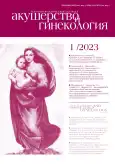Feasibility of preimplantation genetic testing for aneuploidy in patients undergoing in vitro fertilization after conservative treatment of atypical hyperplasia and early endometrial cancer
- Authors: Krasnopolskaya K.V.1,2, Novikova O.V.2,3, Isakova K.M.1, Shostenko L.V.1, Rau D.I.1, Shishkina A.V.1
-
Affiliations:
- Moscow Regional Research Institute of Obstetrics and Gynecology
- Reproductive Health Clinic «PRIOR CLINIC»
- M.F. Vladimirsky Moscow Regional Clinical Research Institute
- Issue: No 1 (2023)
- Pages: 76-82
- Section: Articles
- Published: 15.01.2023
- URL: https://journals.eco-vector.com/0300-9092/article/view/250077
- DOI: https://doi.org/10.18565/aig.2022.245
- ID: 250077
Cite item
Abstract
Full Text
About the authors
Ksenia V. Krasnopolskaya
Moscow Regional Research Institute of Obstetrics and Gynecology; Reproductive Health Clinic «PRIOR CLINIC»
Email: ksu0207@mail.ru
Dr. Med. Sci., Professor, Corr. Member of the RAS; Head of the Department of High Reproductive Technologies, Obstetrician-Gynecologist
Olga V. Novikova
Reproductive Health Clinic «PRIOR CLINIC»; M.F. Vladimirsky Moscow Regional Clinical Research Institute
Email: onov@bk.ru
Dr. Med. Sci., Professor, Obstetrician-Gynecologist, Oncological Gynecologist; Department of Obstetrics and Gynecology
Kamila M. Isakova
Moscow Regional Research Institute of Obstetrics and Gynecology
Email: isa-kama@yandex.ru
PhD, Obstetrician-Gynecologist, Researcher
Lidiya V. Shostenko
Moscow Regional Research Institute of Obstetrics and Gynecology
Email: lidsonnn@gmail.com
Obstetrician-Gynecologist, Postgraduate Student at the Department of Reproduction
Daria I. Rau
Moscow Regional Research Institute of Obstetrics and Gynecology
Email: dariarau23@gmail.com
Obstetrician-Gynecologist, Postgraduate Student at the Department of Reproduction
Anna V. Shishkina
Moscow Regional Research Institute of Obstetrics and Gynecology
Email: anya.shostenko@yahoo.com
Obstetrician-Gynecologist, Postgraduate Student at the Department of Reproduction
References
- Treff N.R., Marin D. The "mosaic" embryo: misconceptions and misinterpretations in preimplantation genetic testing for aneuploidy. Fertil. Steril. 2021; 116(5): 1205-11. https://dx.doi.org/10.1016/j.fertnstert.2021.06.027.
- Kuliev A., Rechitsky S. Preimplantation genetic testing: current challenges and future prospects. Expert Rev. Mol. Diagn. 2017; 17(12): 1071-88. https://dx.doi.org/10.1080/14737159.2017.1394186.
- Verlinsky Y., Kuliev A. Human preimplantation diagnosis: needs, efficiency and efficacy of genetic and chromosomal analysis. Baillieres Clin. Obstet. Gynaecol. 1994; 8(1): 177-96. https://dx.doi.org/10.1016/s0950-3552(05)80031-8.
- Fragouli E., Alfarawati S., Spath K., Wells D. Morphological and cytogenetic assessment of cleavage and blastocyst stage embryos. Mol. Hum. Reprod. 2014; 20(2): 117-26. https://dx.doi.org/10.1093/molehr/gat073.
- Greco E., Litwicka K., Minasi M.G., Cursio E., Greco P.F., Barillari P. Preimplantation genetic testing: where we are today. Int. J. Mol. Sci. 2020; 21(12): 4381. https://dx.doi.org/10.3390/ijms21124381.
- Gonzalez, X.V., Odia R., Naja R., Serhal P., Saab W., Seshadri S., Ben-Nagi J. Euploid blastocysts implant irrespective of their morphology after NGS-(PGT-A) testing in advanced maternal age patients. J. Assist. Reprod. Genet. 2019; 36(8): 1623-9. https://dx.doi.org/10.1007/s10815-019-01496-9.
- Delhanty J.D. Preimplantation diagnosis. Prenat. Diagn. 1994; 14(13): 1217-27. https://dx.doi.org/10.1002/pd.1970141307.
- Dahdou E.M., Balayla J., Audibert F.; Genetics Committee. Technical update: preimplantation genetic diagnosis and screening. J. Obstet. Gynaecol. Can. 2015; 37(5): 451-63. https://dx.doi.org/10.1016/s1701-2163(15)30261-9.
- Малышева О.В., Бичевая Н.К., Гзгзян А.М., Глотов О.С., Кинунен А.А., Лобенская А.Ю., Мекина И. Д., Полякова И.В., Пуппо И.Л., Сайфитдинова А.Ф., Щербак С.Г., Коган И.Ю. Технологические платформы преимплантационного генетического тестирования на анеуплоидии: сравнительная эффективность диагностики хромосомной патологии. Акушерство и гинекология. 2020; 4: 65-71. https://dx.doi.org/10.18565/aig.2020.4.65-71.
- Савостина Г.В., Перминова С.Г., Екимов А.Н., Веюкова М.А. Преимплантационное генетическое тестирование эмбрионов на анеуплоидии: возможности, проблемы и перспективы. Акушерство и гинекология. 2021; 11: 42-9. https://dx.doi.org/10.18565/aig.2021.11.42-49.
- Валиахметова Э.З., Кулакова Е.В., Скибина Ю.С., Грязнов А.Ю., Сысоева А.П., Макарова Н.П., Калинина Е.А. Неинвазивное тестирование преимплантационных эмбрионов человека in vitro как способ прогнозирования исходов программ экстракорпорального оплодотворения. Акушерство и гинекология. 2021; 5: 5-16. https://dx.doi.org/10.18565/aig.2021.5.5-16.
- Liu K.E., Hartman M., Hartman A. Management of thin endometrium in assisted reproduction: a clinical practice guideline from the Canadian Fertility and Andrology Society. Reprod. Biomed. Online. 2019; 39(1): 49-62. https://dx.doi.org/10.1016Zj.rbmo.2019.02.013.
Supplementary files









